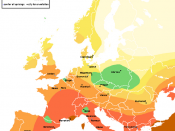Life in England and France in the 14th century was full of unrest and uncertainty. The late Middle Ages was a time of mass death caused by disease, war and famine. Life during this time was made less stable and prosperous due to many factors. First, England and France engaged in horrifying war. The Hundred Years' War was fought between England and France during the 14th century. The war, which was mainly a debate over land claims, led to problems not only economically, but also religiously. France and England supported different popes, which led to the elongation of the debate over the great schism. Along with this great war, a new horrific disease began to surface. The cause of the disease was unknown at the time, but many factors aided in the spreading of the bacteria. A climate change occurred in Europe, leading to the beginning of a famine. Because of this little ice age, wheat was unable to grow and ripen.
People, as well as farm animals began to become weak and vulnerable to disease. These factors, along with the increase in the bacteria Bacillus led to the beginning of the Black or Bubonic plague. With nearly one third of the population decreased, the plague was seen as an equal opportunity killer. Widespread fatalities along with economic disruptions led to more uncertainty in the 14th century.
The Hundred Years' War had its roots in a dynastic quarrel between land. England and France were disagreeing on the distribution of land and saw war as the only outlet. Flanders, one of the disputed territories, was controlled by England. Flanders had grown to be the industrial center of Europe, with a big market of wool and cloth. France, however, felt they had claims to the land because the counts of Flanders had...



A little repetitive
Because your essay structure has no consistent flow it is very repetitive. Keep ideas together for a more comprehensive essay. Also note that the minor spat between the French and English royalty (100 year war) had a lot to do with a dispute over the succession of the French crown.
9 out of 9 people found this comment useful.